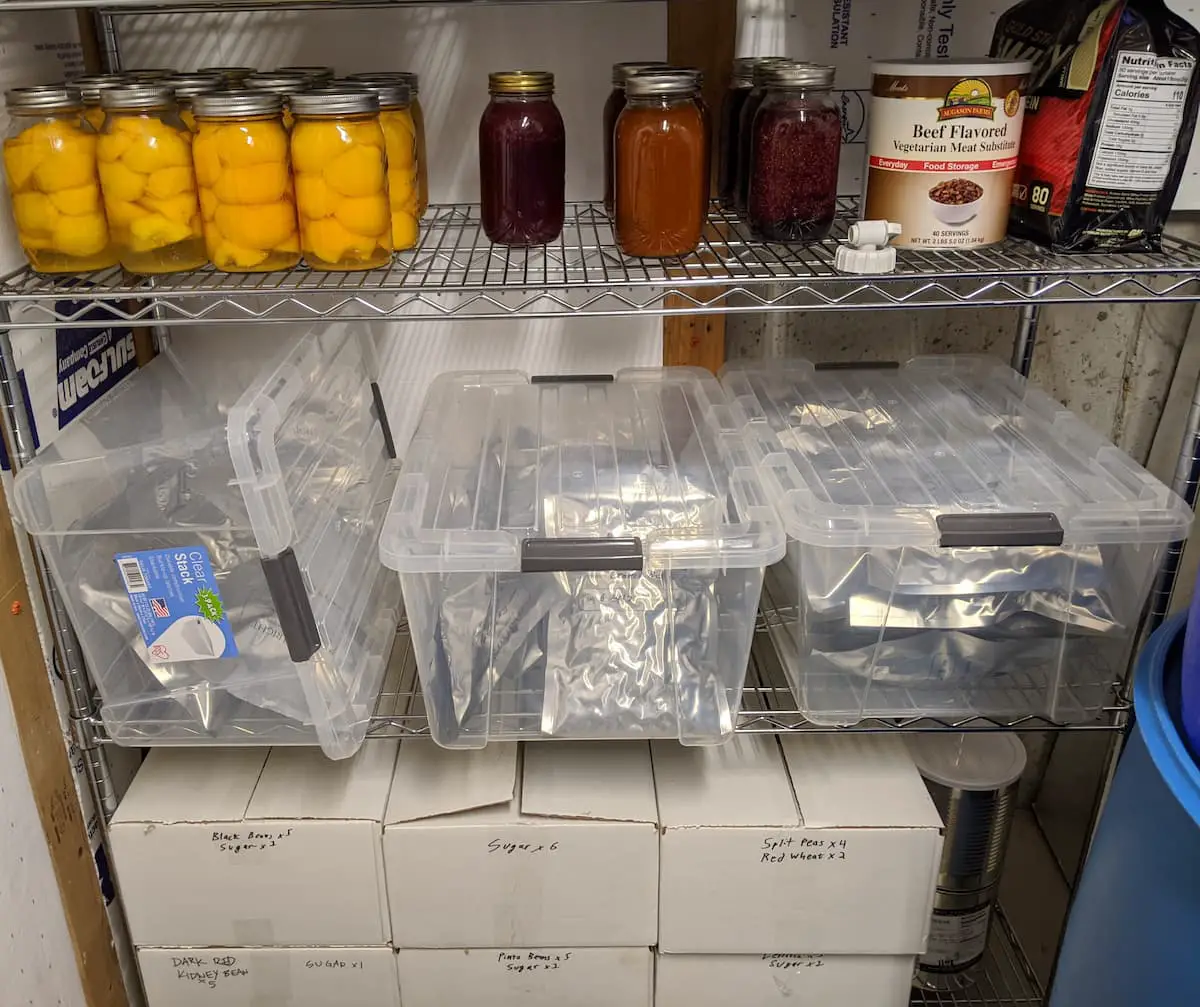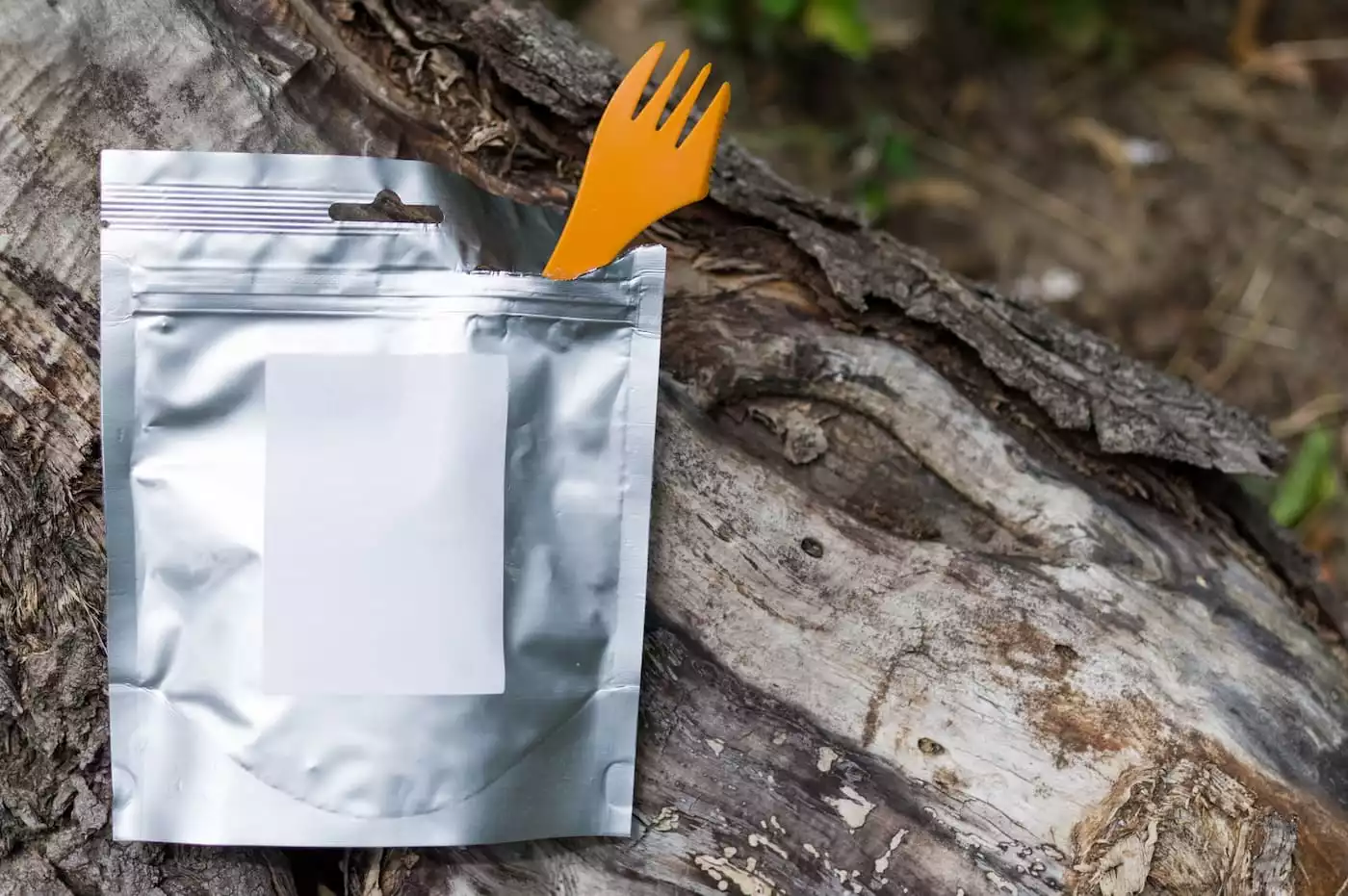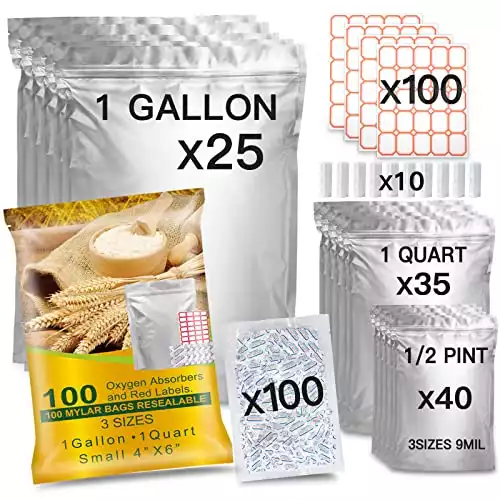When it comes to food storage, it’s always good to have both a short-term and long-term plan in place. That way, you’ll be prepared for whatever the emergency or occasion is which has you dipping into your food storage. But that brings up an interesting question – can you freeze food in Mylar bags?
In general, you can freeze food in mylar bags, but only for short-term storage. Otherwise, it is not recommended. This is because putting the mylar bag in a freezer renders the oxygen absorbers used in the mylar bags ineffective, significantly reducing the shelf life.
If you don’t plan on storing the food long-term, skip using the oxygen absorbers to avoid wasting them. They’re cheap, but wasted costs add up quickly. If the plan is for long-term food storage, you need oxygen absorbers. In any case, keep reading – and let’s talk about storing food, freezing food, and all things related to mylar bags.

Can You Freeze Food in Mylar Bags?
Generally, you can freeze food in mylar bags. They’re hugely versatile that way. But if you put them in the freezer to store, you’re just using the mylar bag as a fancy freezer storage bag. In that case, you could also use cheaper storage options, like Ziploc freezer bags, freezer-safe storage containers, or whatever else you fancy.
Because once a mylar bag goes in the freezer, the freezing becomes the primary preservation agent. So if you’ve got any oxygen absorbers in the bag, they’re not doing a whole lot. They might give you some peace of mind, but that’s about it.
But to understand why this is the case, let’s take a step back and get an overview of what mylar bags are – so you’ll see what I mean.
Mylar Bags -What are they?
Mylar bags are food preservation bags made from biaxially oriented polyethylene terephthalate (BoPET), a particular type of metalized polyester film which can be seen in other materials such as aluminum foil.
They are used in the production of mylar bags, mylar being the trademark name of BoPET in some countries such as the U.S. and UK. The general public favors them in long-term food storage due to specific properties that they possess, which are:
- Its tensile strength. Mylar bags don’t break or damage easily. So don’t be too worried about a puncture hole occurring.
- Permeability. It doesn’t easily permit gases and aroma into it. Therefore, it’s suitable for preserving the original scent of food stored in it.
- It reflects most of the light that falls on it. This creates an unsuitable environment for most microorganisms and pests to live in.
- Sealability. This makes it easy for the mylar bag to be sealed when heat is applied.
Translation: mylar bags are perfect for storing food. They’re versatile, store easy, and last a long time. They don’t stack well, so you will want to put them in a tub so they aren’t slip-sliding all over your food storage (or your freezer). But they last – and they keep food well-preserved with an oxygen absorber.
Can Mylar Bags Be Frozen?
In general, mylar bags can be frozen safely. In various homesteading forums around the internet, plenty of folks use mylar bags as part of their freezer food storage plan.
Personally, I don’t freeze mylar bags. This is a personal decision related to costs and using tools where they’re best suited. Again, that’s based on my own preferences. I’ll explain it at the end of this article.
Should I Freeze My Food Before Storing It in Mylar Bags?
Freezing your food before storing it in a mylar bag is a great option when you want to freeze dry afterward because it helps extend the shelf life of the food item, but this needs to follow a particular procedure. Or will you use your mylar bag to store frozen food in the freezer? Sure, you could do that. It’s an expensive use of mylar bags, considering there are many equally usable containers for freezer storage. But it’s a totally valid use.
On the other hand, if you’re freezing for different reasons, such as preventing insect eggs from hatching, it’s not a great idea. This is because food such as beans that have just been frozen will eventually melt off any ice on it, and when the ice melts, what do you have? Water!
The moisture content at a certain percentage (between 10% to 35%) can cause what is known as botulism. The Clostridium botulinum bacteria cause this condition in a low-oxygen environment.
Botulism is very poisonous, and you should never eat food contaminated with it! Botulism is a severe problem. When I worked as a nurse in the emergency room, we saw it a few times – and we were generally lucky to figure out that’s what it was before the patient got too critical.
If you still choose to freeze your food, then do the following:
- Do not store the food in mylar bags immediately after taking it out of the freezer. Let the food rest in an open space till it is at room temperature.
- For certain foods like mushrooms, you can gently pat them down with a clean dry towel to cause them to reach room temperature faster and remove excess moisture.
- If you have a freeze dryer, put it into the freeze dryer after taking it out of the freezer. A simple test to check if it has been properly freeze-dried is to check for brittleness. If it snaps like a twig, it’s suitable for storing in mylar bags. For those extra cautious, pack them in zip-lock plastic bags for 12-36 hours and look out for any moisture on the bag.
I’ve got complete guides to freeze-drying foods, so make sure you read those. They’ll show you how to freeze dry foods and transfer them safely to store the dry foods in mylar bags with a middle step to check for surprise condensation.
If you aren’t planning on freeze-drying the food after putting it in the freezer, don’t bother. It will save you the stress of removing the excess moisture content in it.
How Do You Store Food in Mylar Bags Long-Term?
There are three main factors every living creature needs to survive, and they are water, light, and air. So when storing food in mylar bags long-term, the aim is to eliminate these three factors, which is practically close to impossible, or the more viable option, which is to keep them at a minimum.
We will need to consider these three factors to look at how to store food in mylar bags for long term.
Tip #1: Remove as much water as possible.
Removing sufficient moisture from the food item before storing it in mylar bags prevents the growth of bacteria, yeast, and mold. Methods to consider to dry your food include
- Use a dehydrator or a freeze-dryer.
- Sun-drying. A method used by even our ancestors. It takes about 48-72 hours to dry the food using this method entirely, and it works best when humidity is low.
- Air drying. It Doesn’t require sunlight, just an environment with good airflow and low humidity. Much like hanging your clothes out to dry. The food item should be dried in an area where it won’t be exposed to dust or other pollutants.
- Freeze drying. This method may not be meant for everyone as it costs between $1900 to as much as $38000 to acquire a freeze dryer but if you can afford one, then it’s strongly recommended.
- Microwave and oven drying. Based on expert opinion, this is the least recommended. This is because oven drying consumes a lot of energy and there is a tendency that your food could end up being cooked if it is not set at the right temperature. Microwave drying most times changes the taste of the food being dried and you wouldn’t want that.
Tip #2: Remove as much air as possible.
In an environment devoid of air, more specifically oxygen, most if not all microorganisms and pests would not survive and that includes the eggs of insects. When storing food in a mylar bag, the two methods to consider are:
- The use of oxygen absorbers. The correct volume of oxygen absorbers should be used for the correct volume of the mylar bag. This absorbs only oxygen. Sometimes you may notice a bulge that seems like air is still inside it, rest easy, it’s other gases such as nitrogen in it and it won’t be a problem. The table below shows the amount of oxygen absorber you will need depending on the volume of the mylar bag being used.
- The use of a vacuum sealer. This completely sucks out the air in the mylar bag before sealing it. You shouldn’t expect to see any bulge as no gas should be in it. In my experience, most mylar bags don’t work well with a vacuum sealer. Maybe it’s just my vacuum sealer.
Once the bag has as much air removed as possible, we use an impact sealer to double-seal the bag. That way, if one seal fails, we’ve got a backup. It’s all part of removing and keeping the air away from the stored food.
| The volume of the mylar bag | The volume of the oxygen absorber required |
|---|---|
| ¼ gallon | 100cc: 1 500cc: 1 1000cc: 1 2000cc: 1 |
| ½ gallon | 100cc: 1-2 500cc: 1 1000cc: 1 2000cc: 1 |
| 1 gallon | 100cc: 3-4 500cc: 1 1000cc: 1 2000cc: 1 |
| 1.5 gallons | 100cc: 5-8 500cc: 1-2 1000cc: 1 2000cc: 1 |
| 2 gallons | 100cc: 10 500cc: 2 1000cc: 1 2000cc: 1 |
| 4.25, 5, and 6 gallons | 100cc: 20 500cc: 4 1000cc: 2 2000cc: 1 |
Tip #3: Keep Your Stored Food Out of Direct Sunlight.
The light being referred to you here is light from a natural source, such as sunlight. So a dark environment would be ideal for storing your mylar bags in. Factors to consider include:
- The mylar bag should be thick enough between 4.5 mil to 7 mil to prevent light penetration.
- Do not use a mylar bag with a clear window. This is an excellent avenue for light to get in. If you do use mylar bags with clear windows, keep them for short-term storage rather than long term food storage.
- Keep food storage out of direct sunlight. Ideal places for long-term storage include closets, under the bed, cold storage, etc.
Best Places to Get Mylar Bags
The best two places to get Mylar bags are directly from Harvest Right or from Amazon. Buying from Amazon is usually the better route if you’re looking at price.
A 50-pack of 6" x 9.75" mylar bags are food-grade and rated for long-term storage.
Final Thoughts on Freezing Food in Mylar Bags
Personally, we treat frozen food as part of our short-term food storage plan. So anything that goes in the freezer, gets used up within 6-12 months at the longest. If we need to store it longer than that? It gets freeze-dried and put into a shelf-stable state so we can store it for years.
Also, mylar bags aren’t exactly cheap. You can get them for a decent price when there’s a sale, but they’re still more expensive than freezer Ziploc bags. We try to balance using the best tool for the job with the best-priced tool for the job.
So in our estimation, it’s a better use of our resources when we use Ziploc freezer bags for the freezer and mylar bags for long-term food storage. You might come to a different conclusion, and that’s all right.
My goal is to make sure you’ve got the best information possible so that you can make an informed decision with the experience behind it. Happy homesteading!
Resources
Learning from your own experience is essential, but learning from others is also intelligent. These are the sources used in this article and our research to be more informed as homesteaders.
- “BoPET.” Wikipedia, Wikimedia Foundation, 17 Mar. 2021, en.m.wikipedia.org/wiki/BoPET.
- “Botulism.” Mayo Clinic, Mayo Foundation for Medical Education and Research, 12 Aug. 2020, www.mayoclinic.org/diseases-conditions/botulism/symptoms-causes/syc-20370262.
- “Drying Food at Home.” UMN Extension, extension.umn.edu/preserving-and-preparing/drying-food.
- “Oxygen Absorbers Recommended Amounts.” USA Emergency Supply, www.usaemergencysupply.com/information-center/packing-your-own-food-storage/oxygen-absorbers-recommended-amounts.
- Starr, Kimberly. “How Much Does a Freeze Dryer Cost? 28 Examples and Factors.” Backyard Homestead HQ, Backyard Homestead HQ, 16 Sept. 2020, backyardhomesteadhq.com/how-much-does-a-freeze-dryer-cost-28-examples-and-factors/.
- Starr, Kimberly. “How to Freeze Dry Mushrooms: 12 Tips You Can’t Miss.” Backyard Homestead HQ, Backyard Homestead HQ, 9 Nov. 2020, backyardhomesteadhq.com/how-to-freeze-dry-mushrooms-12-tips-you-cant-miss/.


